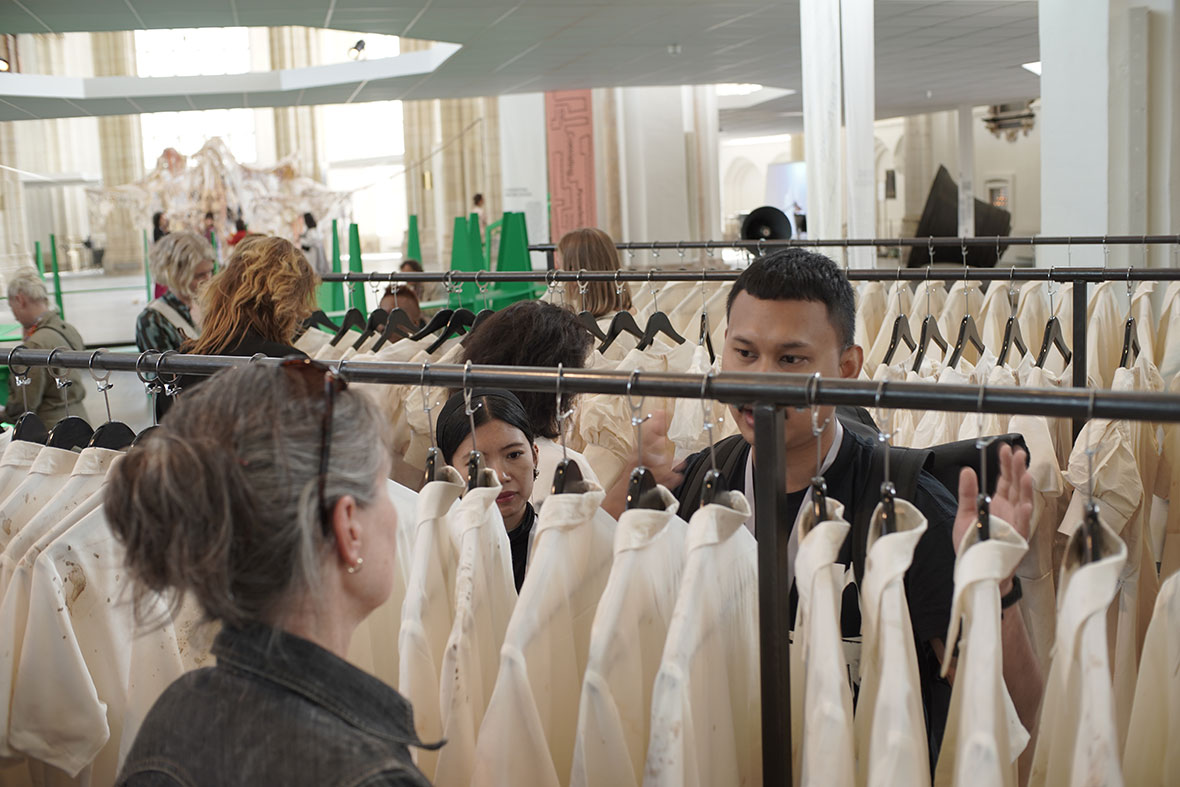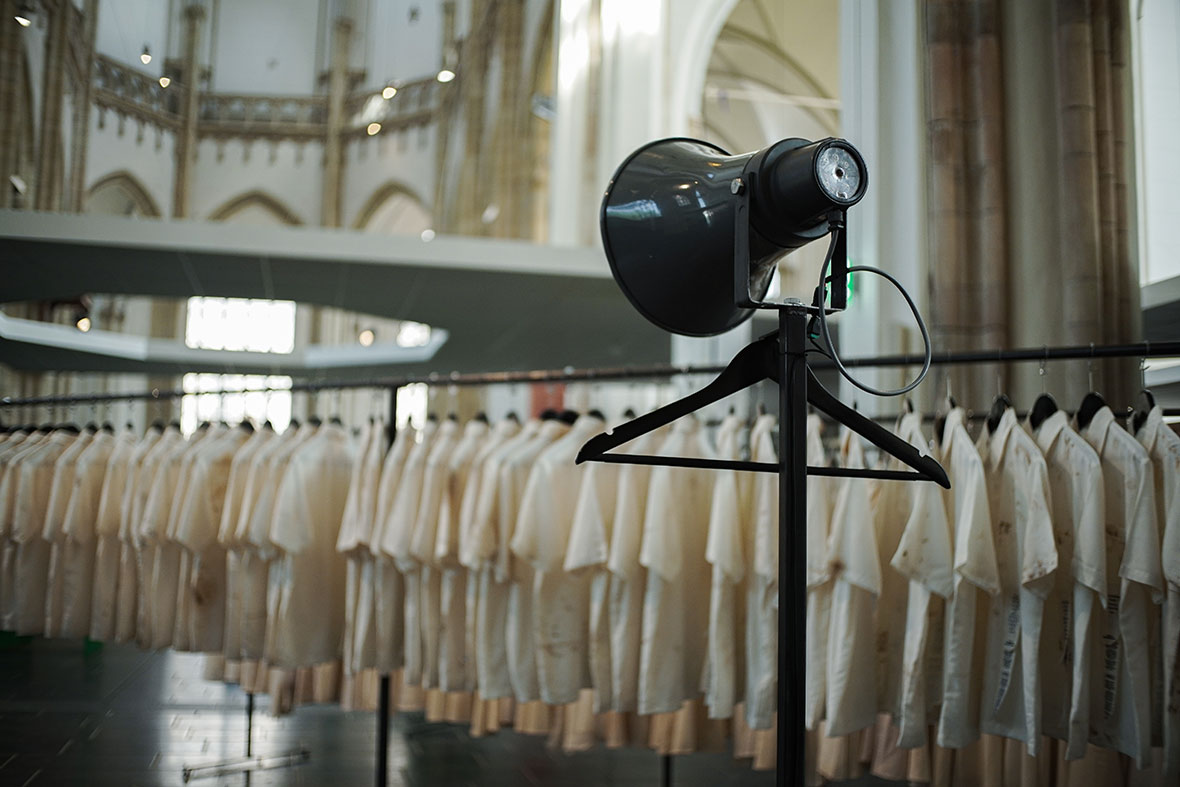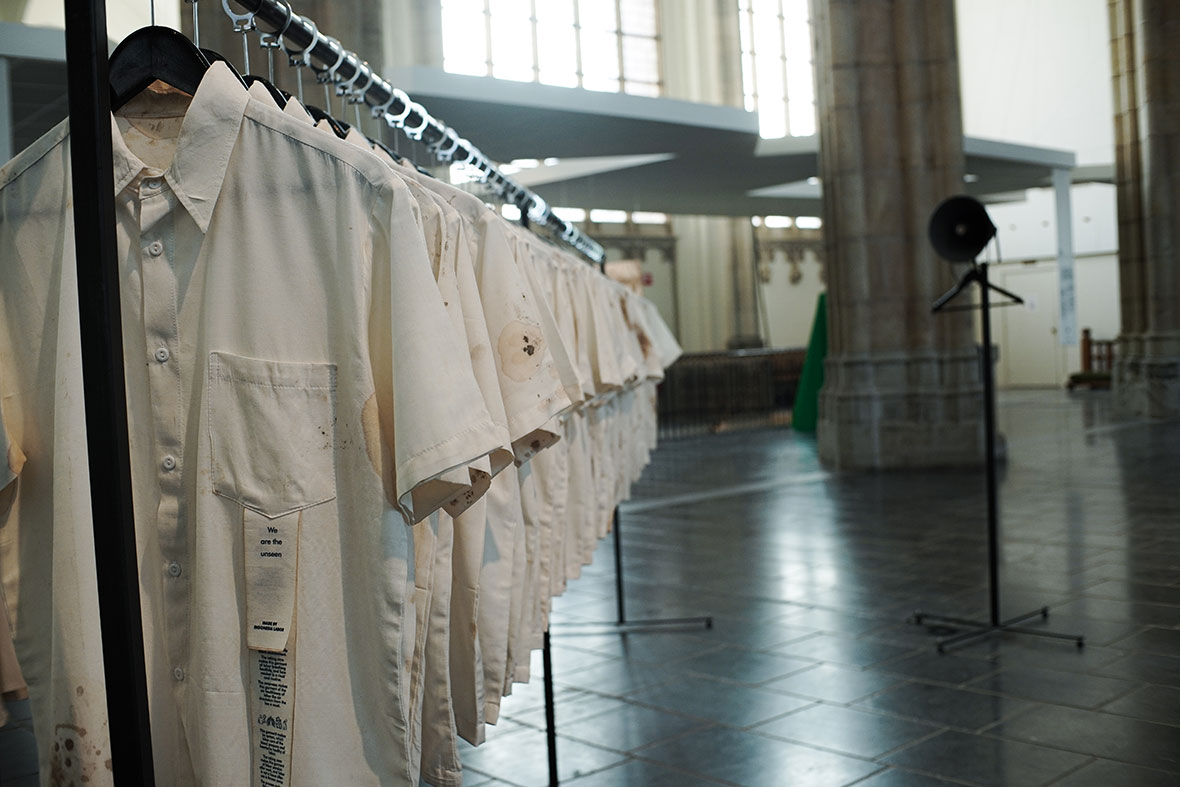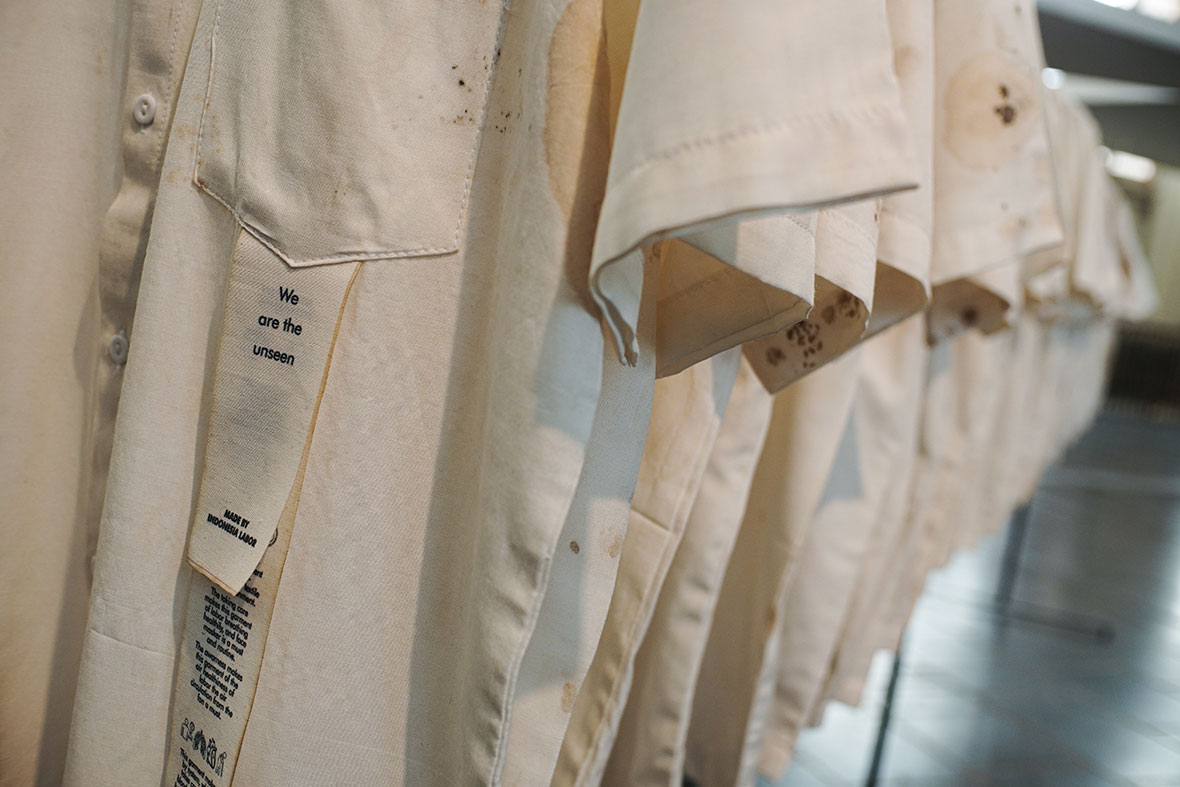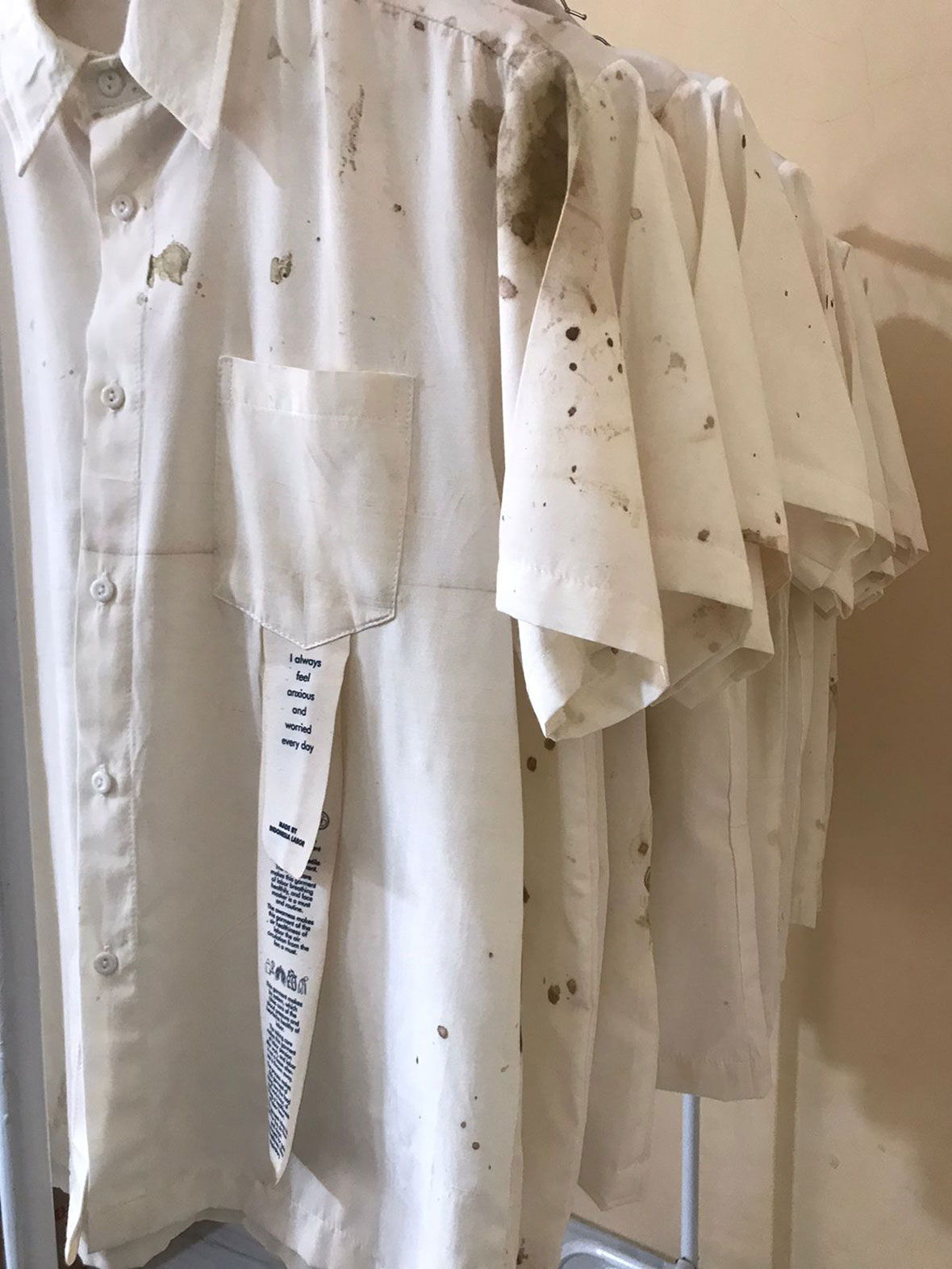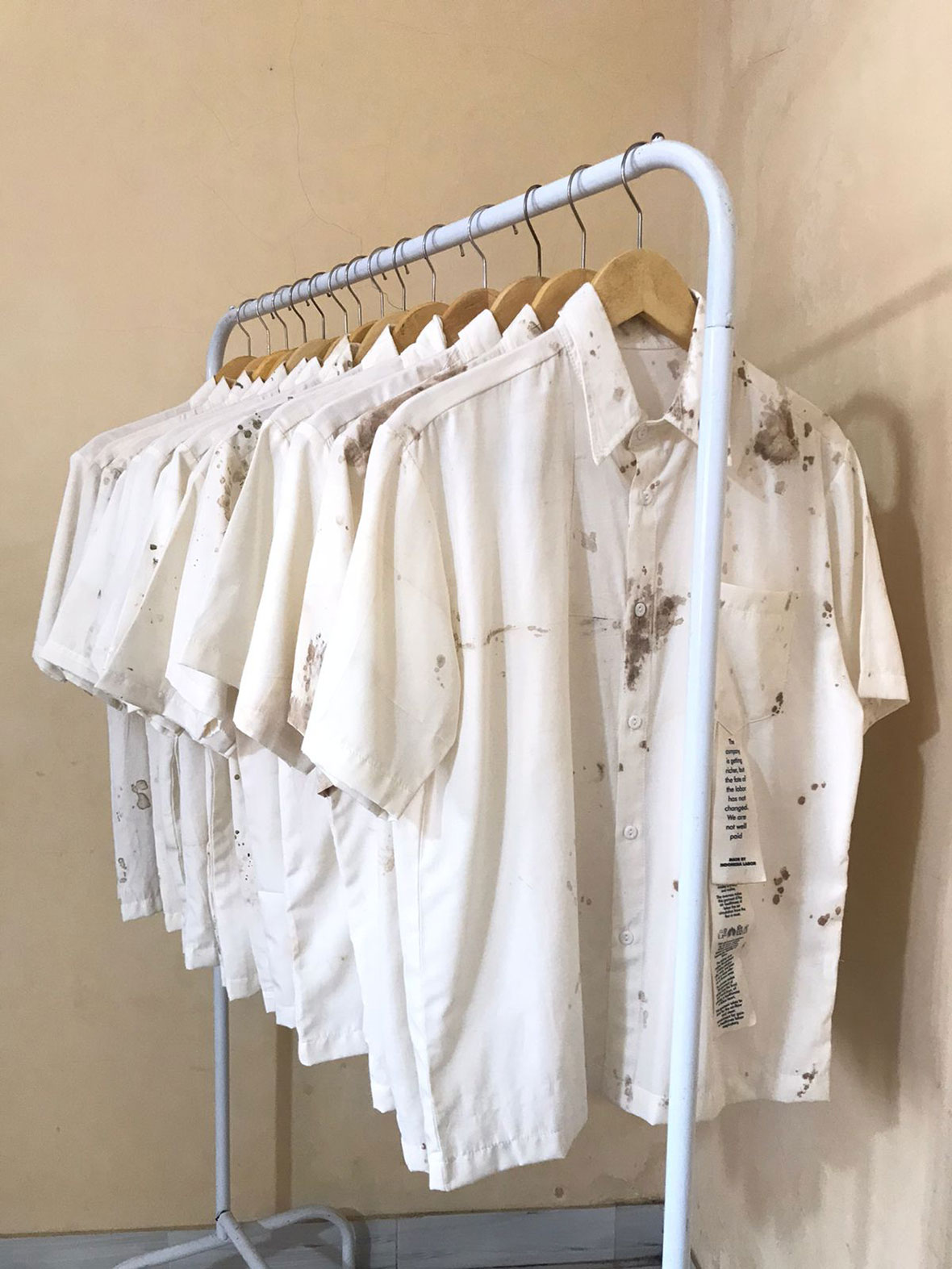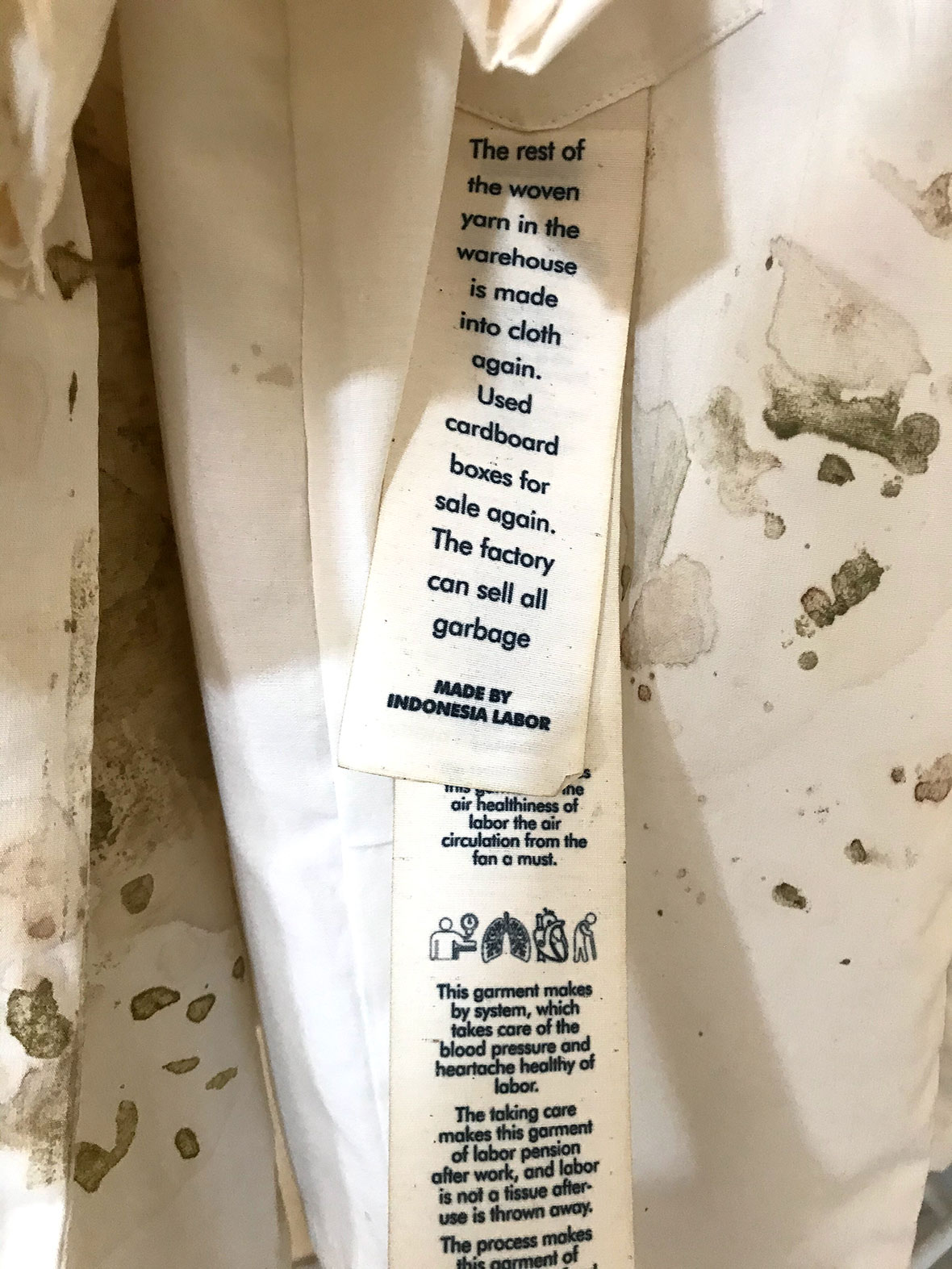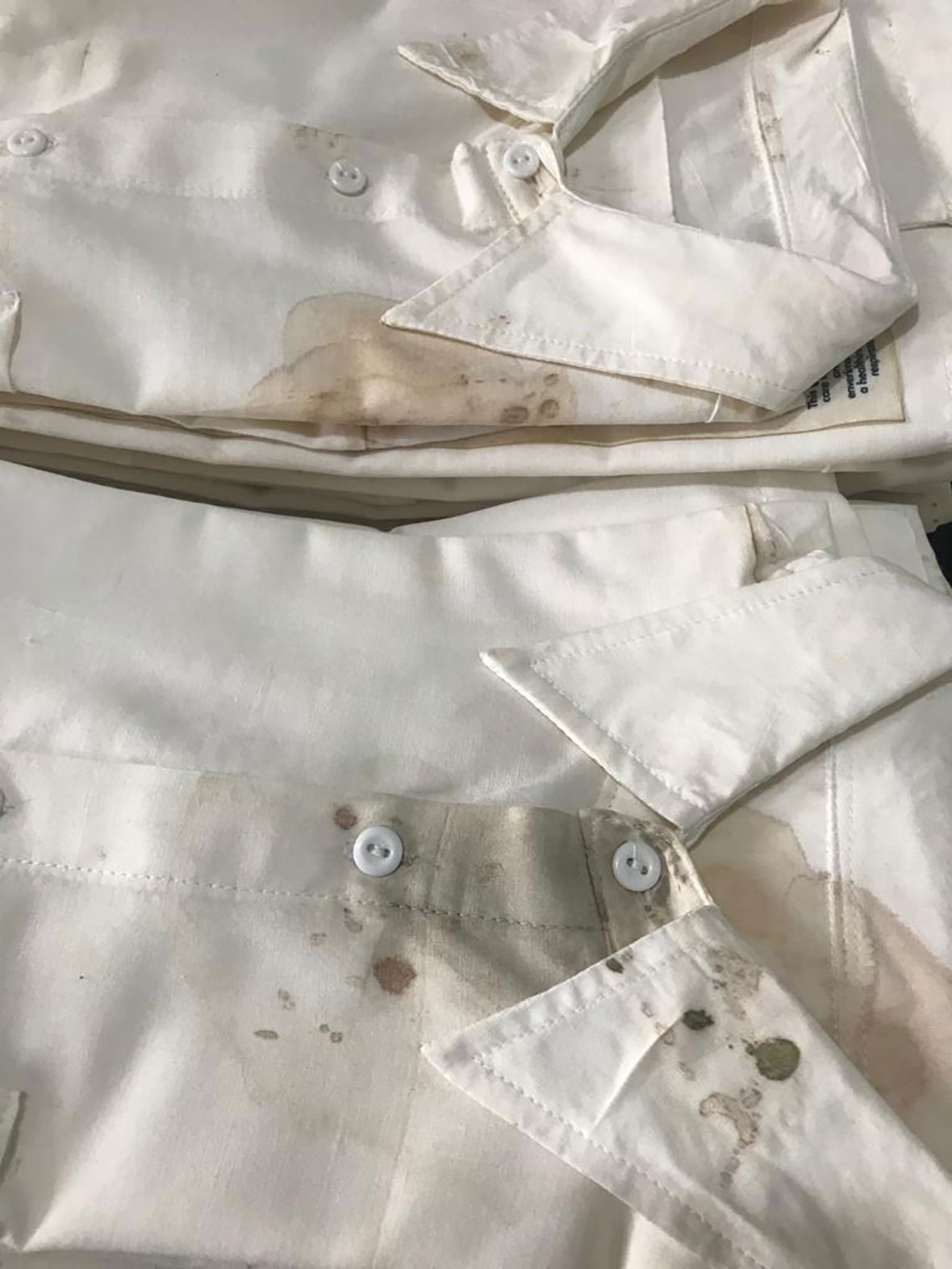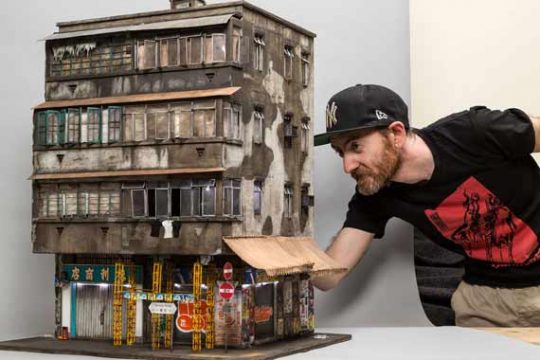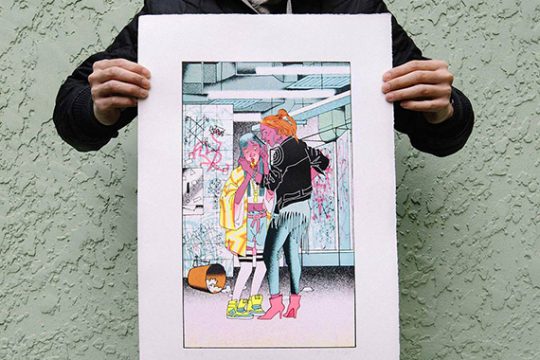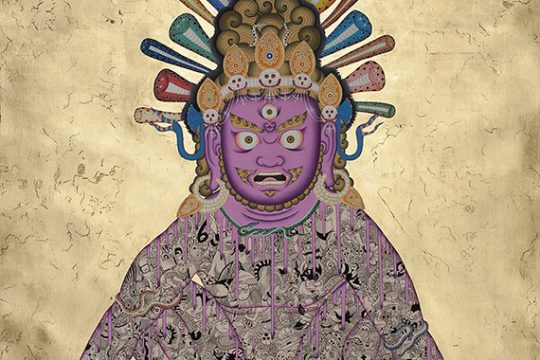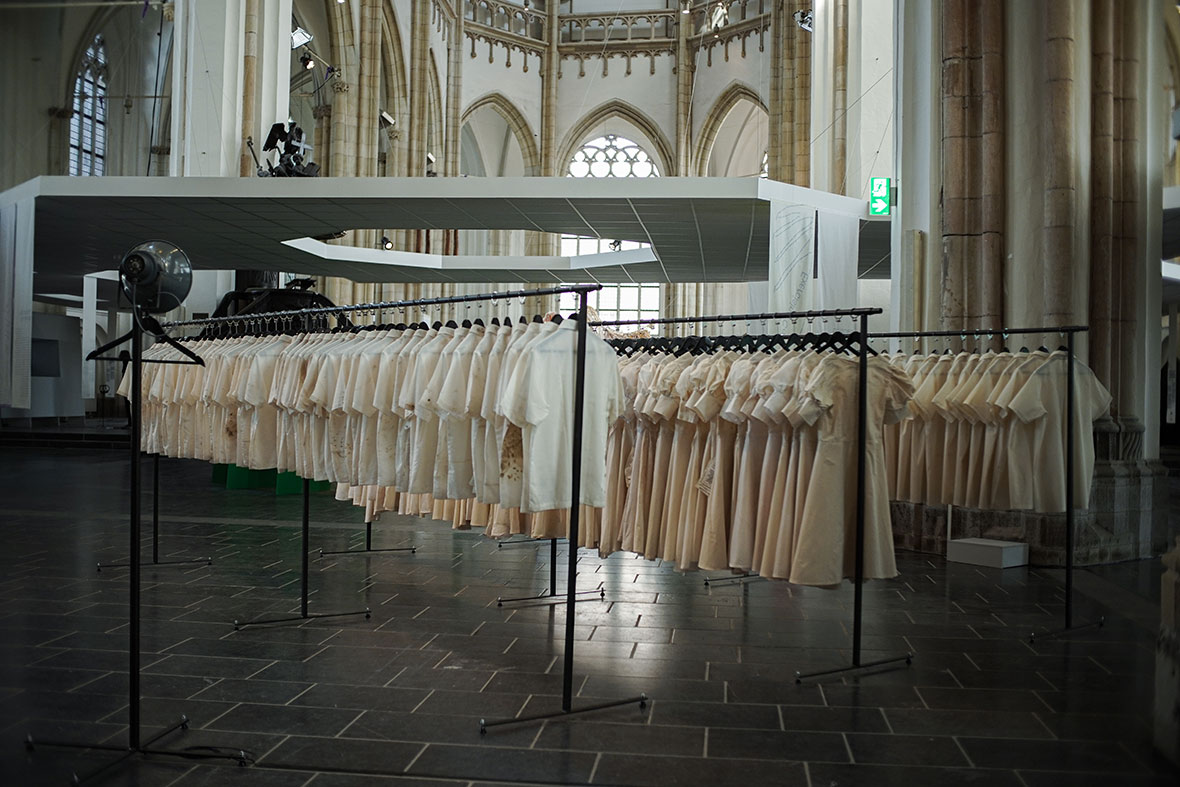
When you’re at the mall shopping for clothes, shirts and pants hang neatly from the racks, pristine and fresh. The smell of new clothes fills the air and raises the spirit. But how did those intoxicating garments get to you? Who made them; what are the conditions at the various factories across the world where they were produced; and what happens to the leftovers and waste along this sprawling supply chain? To get into your hands, those clothes touched the lives of so many people and places. But there, in front of you, all you see is the final result, presented at its best, that long trail behind it very well concealed.
Indonesian designers and artists Widi Asari and Riyadhus Shalihin would like you to think about all this. Their latest installation, Bodies That Consume, displays racks of clothing in rows, all neatly separated under the tall, bright rafters of a repurposed church. But the clothes themselves are far from fresh, the history behind them starkly clear. The path these clothes took is stained deeply into the fabric and design, written plainly in simple prose on its tags.
商场中崭新整齐的衣物,往往为顾客带来一股独特的气味,令你感到清爽、新颖,不自觉地掏向钱包。然而,这些迷人的衣服是如何来到你面前的?它们的制作过程如何展开?在世界各地,生产这些衣服的工厂环境是怎样的?整个庞大的服装供应链中,那些剩余和废弃的物料会被如何处理?这些衣服在到达你面前之前,曾与多少人的生活和地方有过交错?但服装呈现在你面前,你所能看到的只有光鲜亮丽的成果,它们背后的坎坷却已经无迹可寻。
为了引起人们对这些问题的思考,印度尼西亚设计师和艺术家 Widi Asari 和 Riyadhus Shalihin 推出了全新艺术装置作品《肌体消费》(Bodies That Consume),在由教堂改建的高亮的空间内,整齐陈列成数排几乎相同的衣物。与商场不同的是,这些衣服看上去一点也不新,取而代之的是污渍和褶皱,讲述每一件衣服自己的故事。服装所经历的一切被制作进面料和设计中,标签也不再是商标、用料和价格,而是一段段服装背后的故事。
Curated by State Of Fashion and presented alongside artists from Columbia and South Africa, Asari and Shalihin borrow silhouettes from the classic Indonesian workers’ uniforms. They’re stained with rust, mold, and sewage common in local factories. And the tags feature excerpts from interviews with a worker describing the precariousness of life within these factories. Megaphones used in the factory to shout orders at workers are fused to clothing hangers around the racks, playing the worker’s words on a loop along with factory noises, sewing machines, and a river flowing.
此次展览由 State Of Fashion 一手策划,同时展出的还有来自哥伦比亚和南非艺术家的作品。Widi 和 Riyadhus 以传统印尼工服为设计原型,在制服上刻意保留了当地工厂常见的铁锈、霉菌和污水留下的痕迹。标签上的故事,来自工人在采访时的摘录,讲述飘摇不定的工厂生活。工厂里用来向工人施号命令的扩音器,则被固定在一旁的衣架上,循环播放着来自工厂的声音,其中包括了:机械噪音、缝纫机、河流、工人的声音等等。
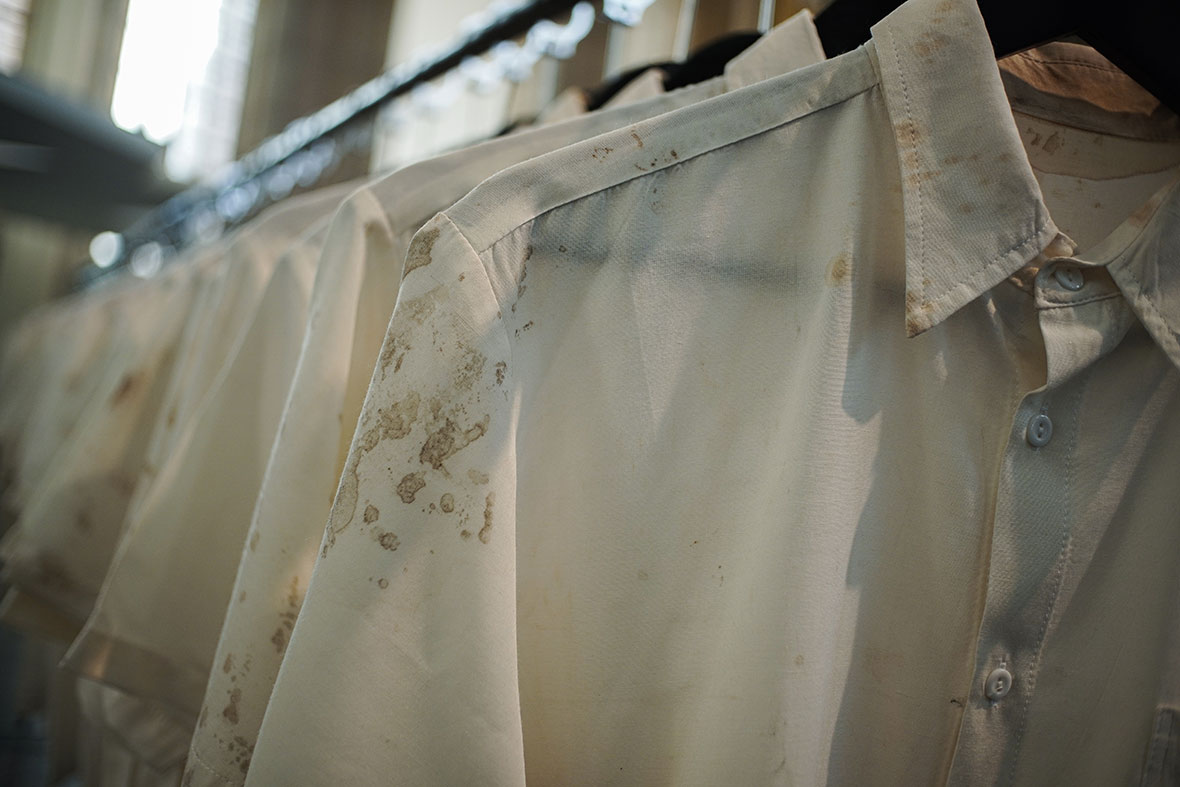
To create authentic representations of workers’ lives, everything is based on real aspects of life in the factories. The basic form is modeled on actual workers’ garments that were used for 25 years. Using a microscope, Asari and Shalihin found traces of black mold in the clothing and rusty sweat stains in its folds and creases. “The microscope reveals what cannot be seen on the ‘capitalism surface.’ Instead, all people see is the profit from buying and selling,” they say. “This a record of the suffering experienced by textile workers that clings to the clothing archives.” It also recalls one of the duties of the workers, who had to closely inspect clothes every day.
为了还原真实的工人生活,装置陈列的服装均以真实工厂生活为原型进行设计。Widi 和 Riyadhus 找来一件在工厂内穿着 25 年之久的制服进行研究,透过显微镜,他们发现了衣服上的黑色霉菌、折痕中的汗渍与泥污。他们说道:“我们仿佛看到了‘资本主义表面’之下不为人知的一面。人们往往只看到买卖之间的利润,而这些痕迹却在讲述纺织工人所经历的痛苦,他们是服装行业历史不可缺少的一部分。”这一件件一模一样的衣服,仿佛映射着工人们日复一日的工作。
For the installation pieces, they reproduced the stains with rust from factory sewage pipes and plants growing in front of polluted streams nearby in their hometown of Bandung City in West Java. The Citarum River, which flows through the city, is one of the world’s most polluted, largely due to textile plant runoff. Although the original pieces were blue, they use beige in the installation to fit the industrialist mood of their theme. The cotton they use to produce them was damaged from mold when they purchased it from Cigondewah, which is the central waste post-production market for industrial textile in Bandung.
服装上的污渍,来源于工厂污水管道的铁锈和一旁的植物。这条流经他们家乡西爪哇万隆市的奇塔伦河 (Citarum) 是世界上污染最严重的河流之一,造成污染的主要原因是附近纺织厂排放的废水。用来制作衣服的棉料从 Cigondewah 购买的发霉棉花,那里是万隆工业纺织的主要废物加工市场。
Although in the artists’ mock-ups, the tags featured proper English, they ultimately use imperfect translations via an app, resulting in weird turns of phrases and improper grammar. “This is an organic representation of the speaker’s colloquial language,” Asari and Shalihin say. “We want to emphasize resistance from a post-colonial country. We’re forced to communicate with the global north in a language that is not our mother tongue. It’s complex and difficult.”
“We look for opportunities to work within a critical view of fashion practices,” Asari says. “As a designer, I’m looking for alternative ways to look at the fashion and textile industries. I want to reveal the complex situation and conditions of the invisible production flow, such as the condition of workers and the environmental conditions of the community around the industrial area.” Shalihin, for his part, focuses on how colonization is rooted in the exploitation of laborers, which he exposes by examining bodies and places on a microscopic scale.
标签上的文字由英文撰写,两位艺术家刻意在文字中加入蹩脚的语法、拼写错误。Widi 和 Riyadhus 表示:“这是为了还原说话者的口语表达。我们想藉此突出来自后殖民国家的抵抗。我们被迫使用非母语的语言与发达国家去交流。这对许多人来说是很复杂和困难的。”
“我们不断寻找机会,以批判性观点探讨时尚实践课题,”Widi 说,“作为一名设计师,我希望能以常人以外的方式来看待时尚和纺织行业。我想揭示生产过程中那些不为人知的复杂条件和环境,例如工人的待遇,以及工业区周围社区的环境状况。”而对 Riyadhus 而言,他更着眼于殖民化对于劳动者剥削问题的深层影响,并通过微观视角,从身体与地点的角度来剖析和揭示该主题。
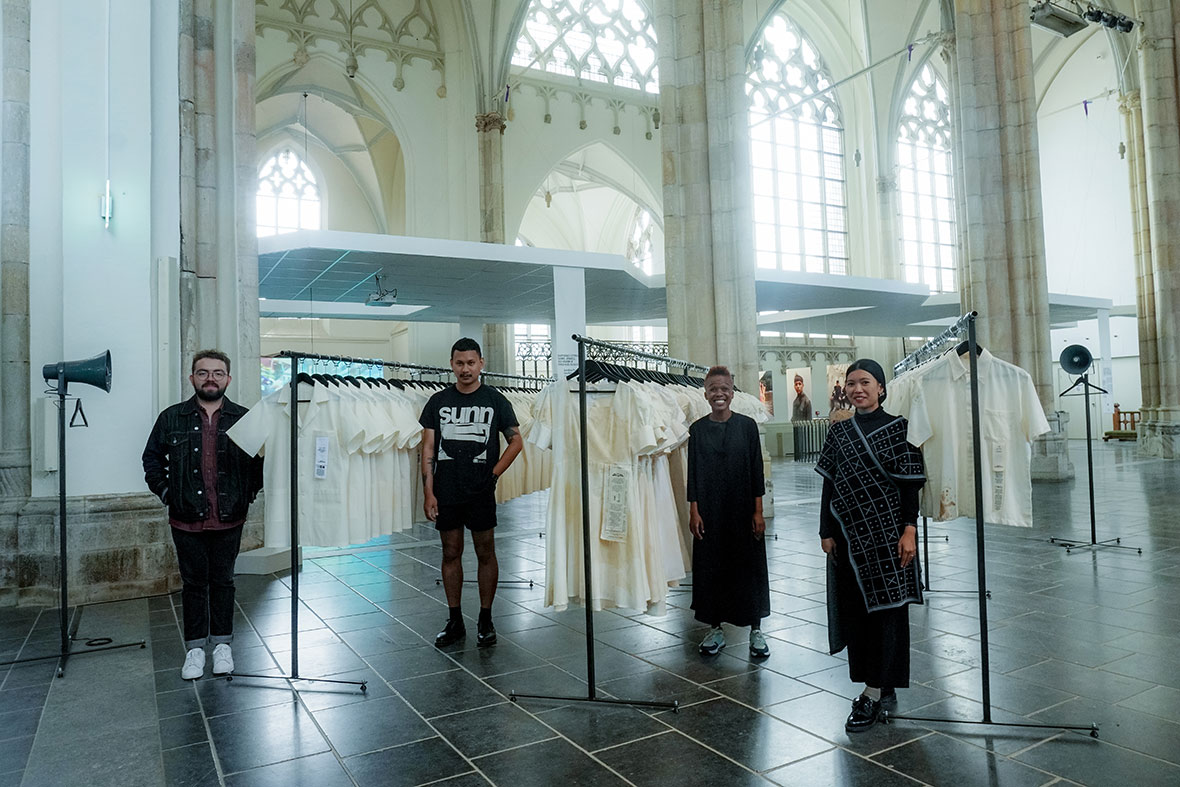
They’ve worked together before, including on a site-specific performance called Lusi Pakan Sumbi; Failure De Couture, which dealt with similar themes but featured stylish clothing and dancers situated in old factories and on display in retail windows. Alongside groups like State Of Fashion, their aim is to inspire radical change the fashion industry around the world.
Indonesia plays a key role in the fashion industry, as a popular manufacturing location for global fast fashion brands like Uniqlo, Zara, H&M. “We provide cheap land, cheap workers, and cheap power to produce garments for wealthy countries,” Asari and Shalihin explain. “Instead of rice fields that could feed us and green open land to keep the air clean, they become textile factories that degrade our social order and environmental health.”
在此之前,两位艺术家已有过合作,其中包括一场名为“败装”(Lusi Pakan Sumbi: Failure De Couture)的艺术活动。其与上述作品探讨相似主题,展出场地被安置在旧工厂和零售橱窗中,集合了服装和舞者表演。他们希望能携手 State Of Fashion 等团体,在全球时尚行业催生变革。
印度尼西亚在时尚行业扮演重要角色,是优衣库、Zara、H&M 等全球快时尚品牌的主要制造基地。Widi 和 Riyadhus 表示:“我们提供廉价的土地、劳动力和电力能源,为发达国家生产服装。曾经用来养活我们的稻田,以及保持清新空气的绿色开阔田地,如今变成了一间间纺织厂。然而,我们的社会秩序和环境健康还在进一步恶化。”
Like our stories? Follow us on Facebook and Instagram.
Instagram:
@asariwidi
@riyadhusshalihin
Contributor: Mike Steyels
Chinese Translation: Olivia Li
Images Courtesy of Taufik Darwis

